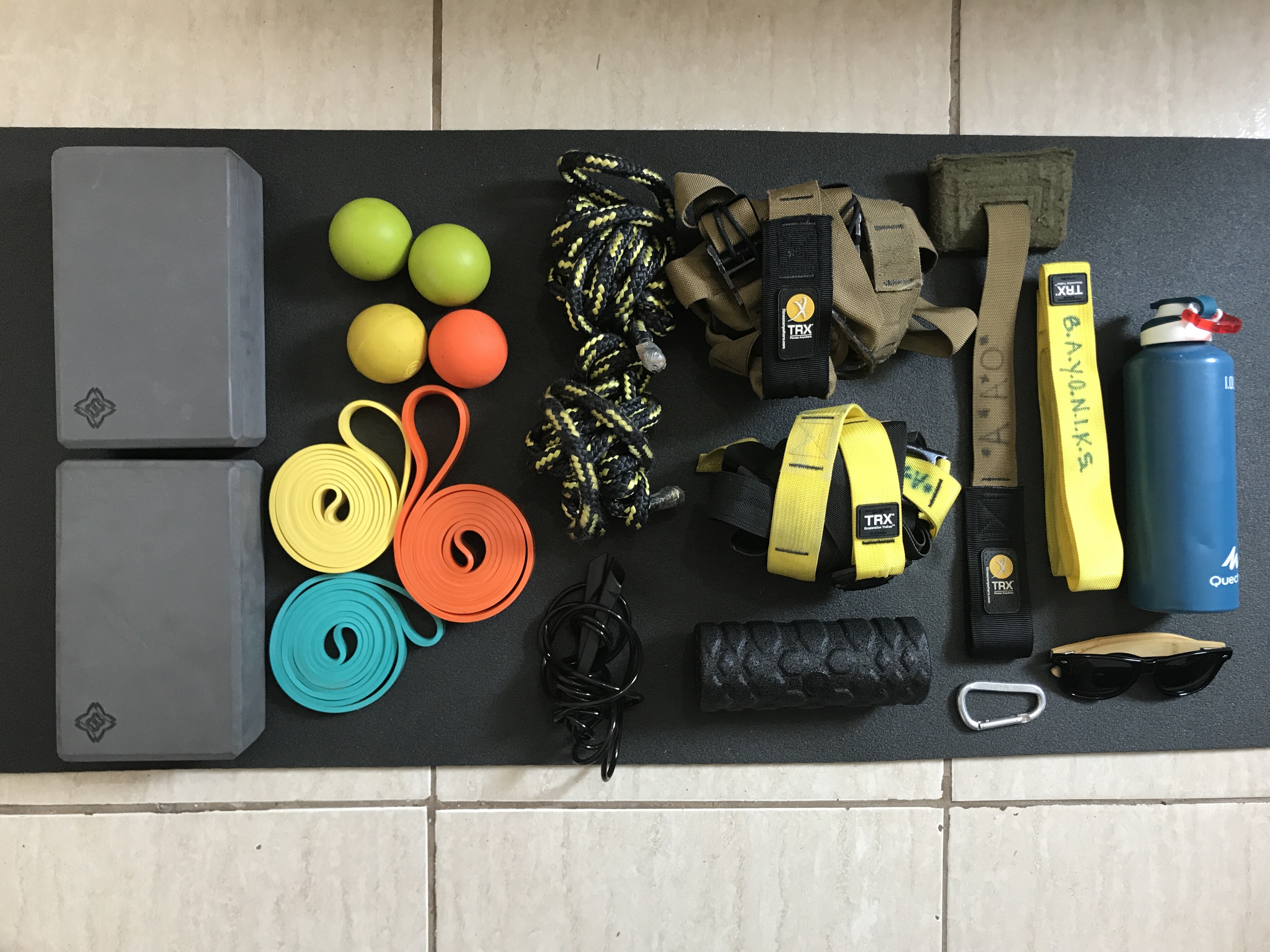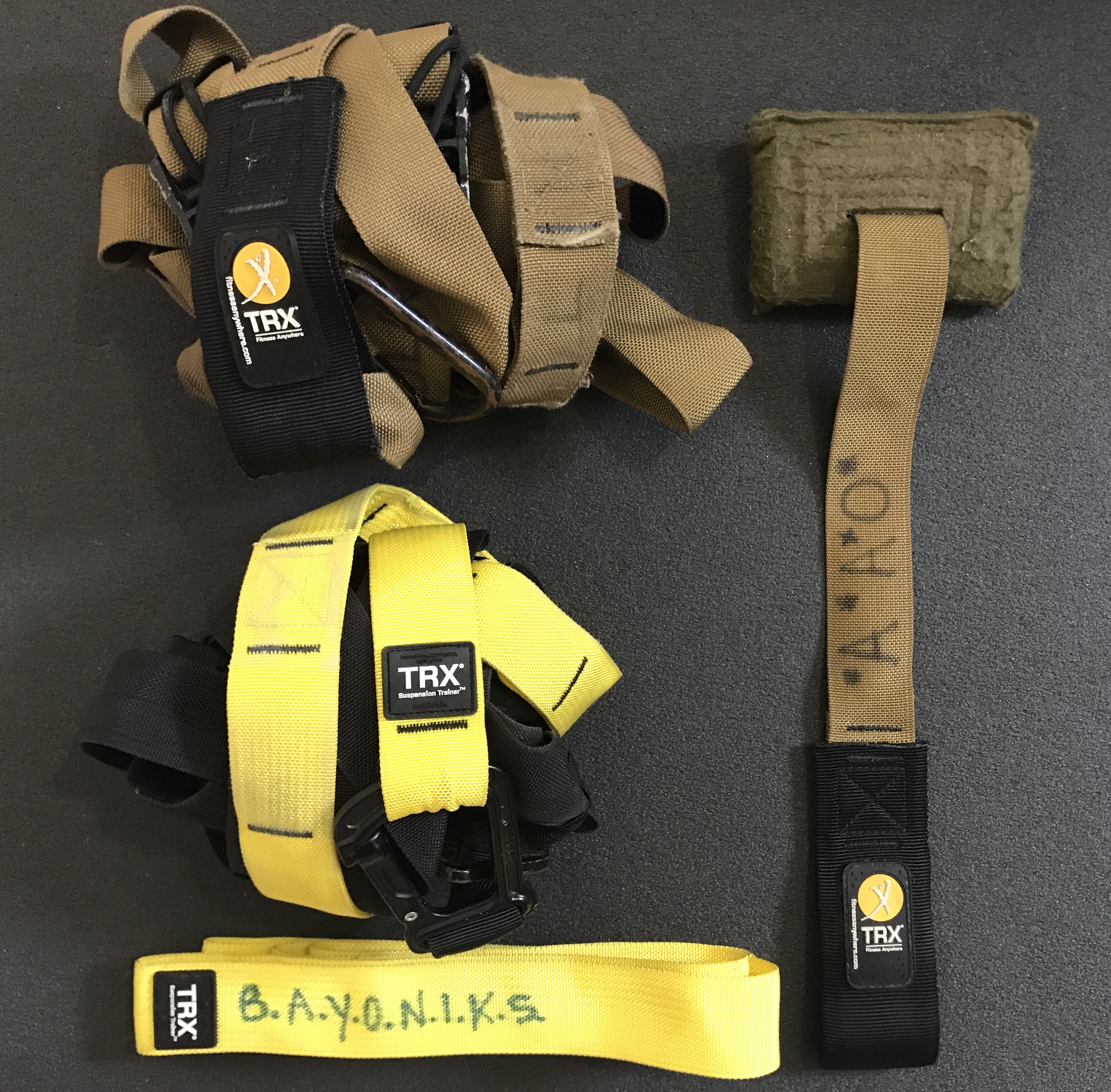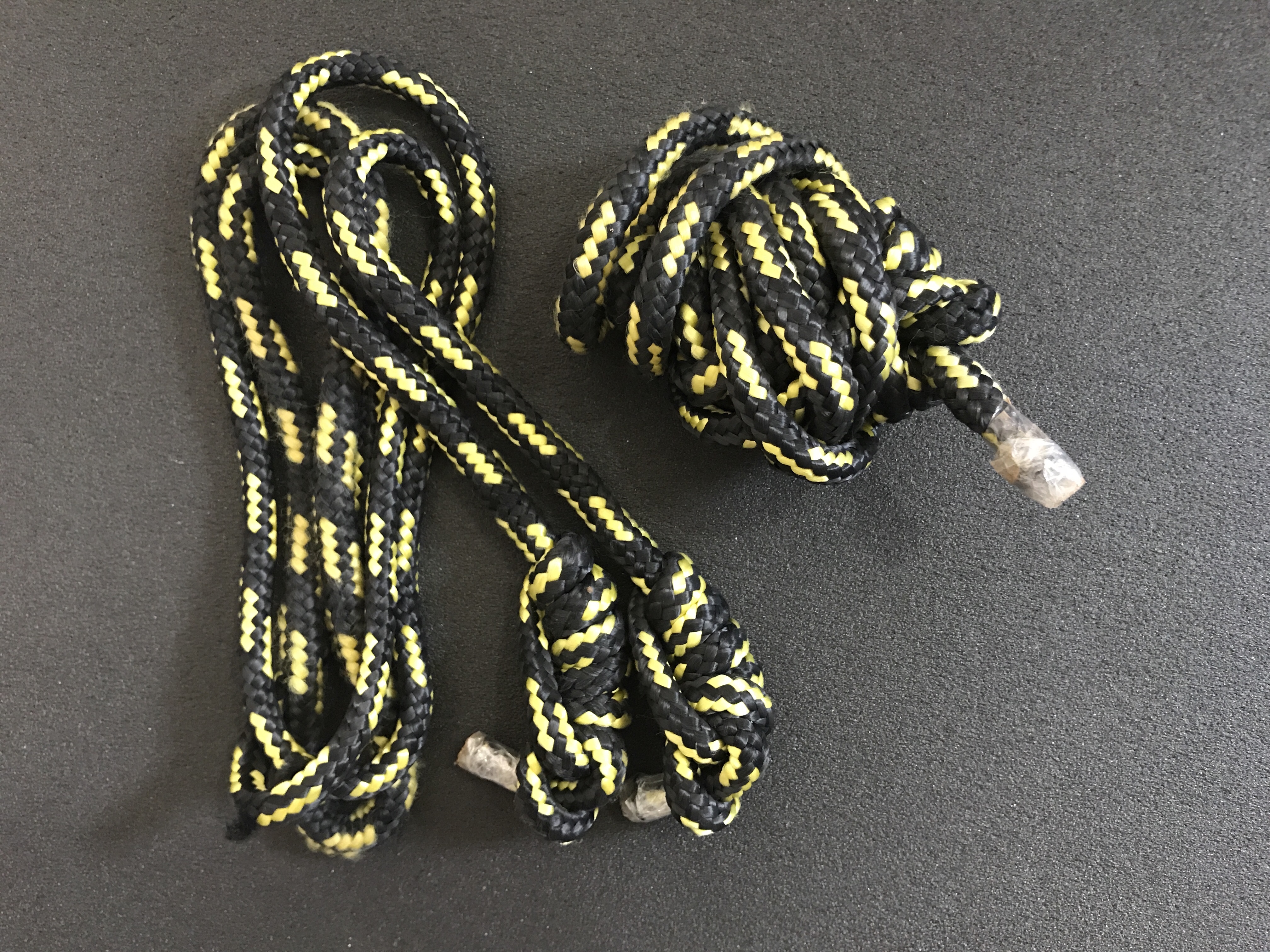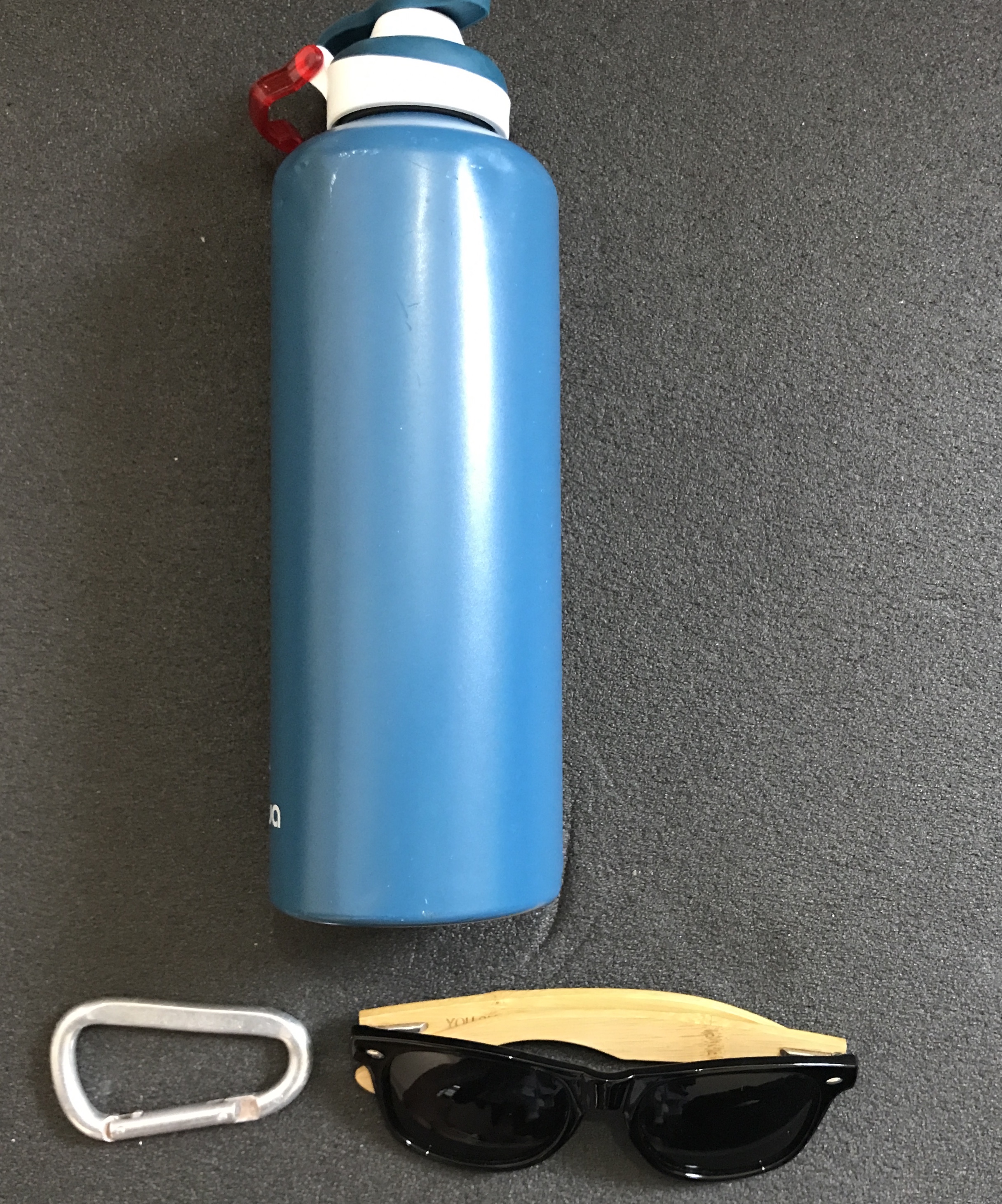
One of the biggest challenges road warriors face is which exercises to do and what equipment to use.
Considering that you have many variables, which you will be exposed to that could interrupt or derail the quality of your workout. It’s absolutely essential that you have consistent non-negotiable staples in your luggage.
Time and time again clients would tell me, “Bayo I don’t know what to expect as far as the hotel gym, or my access to boxing equipment, or if there will be a nearby gym.
By you solidifying the quality of your workout “with or without” a gym, you have the confidence and peace of mind that you can get the results you want.
If there is a fully decked out gym for you to add more, so be it. If there is not, it doesn’t phase you and you keep going. These are the most portable forms of equipment that you can do the most with.
TRX (Total Resistance Exercise) Suspension Training

The TRX (Total Resistance Exercise) Suspension training system is by far my most favorite, versatile, and powerful piece of equipment.
It’s light, durable, and very functional.
The TRX was designed by Navy Seal platoon commander Randy Hetrick. He needed a piece of equipment to use anywhere anytime. His first mockup was a jujitsu belt and a piece of parachute cord.
He later transformed this rough rig into an international fitness favorite.
For B.A.Y.O.N.I.K.S., TRX fills the role of “O” Operational Readiness. Having used TRX for 10 years, I can attest to its primary benefits.
First of all, the TRX forces you to use your own body weight, balance, and coordination to get the workout you want with your muscles.
Secondly, it guarantees that we have the ability to work the body in all planes of motion (Sagittal – think pulling Sagittarius arrow, Frontal – think jumping jacks, and Transverse – think your hands moving like helicopter blades).
Most classic gym equipment you will find was invented for bodybuilding.
While it has been used to create outstanding physiques of size and symmetry, bodybuilding tends to be focused on isolated muscle groups and misses many planes of motion including rotation.
As a traveler, you are picking up luggage, loading luggage, carrying equipment, typing, reading, writing, talking on the phone, and hopefully not throwing anything!
It is far more advantageous for you to do workouts that help you move better, more fluidly, and stronger.
Increasing your posture, decreasing back pain, and neck pain are far more beneficial to you than doing gym exercises that pump up certain muscle groups but leave you in chronic pain.
Finally, bodyweight exercises are everything to the mobile traveler, and usually, there is one huge problem without the TRX, how to work out the backside of your body (aka. the posterior chain which includes your trapezius, back, your glutes, your hamstrings, & calves).
Typically if you only had a bar to do pullups, that would be ok. If you can do pullups – if you can’t you’ll see where rubber super bands come in.
However, even if you have a bar to do pullups there are 3 planes of motion for your back: horizontal rows, narrow grip rows, and coiling core exercises. I cover these in more detail in my coaching programs.
The most important factor is that this piece of equipment will help you work your body from head to tow, build muscle, and burn fat as good as any gym.
RMT Ropes (Weck Method)

The Weck Method was founded by David Weck, inventor of the BOSU ball on the principles and primal movements of swinging, throwing, and locomotion.
If you think about it, what else is your body designed for?
Rather than only focusing on how your body looks, the Weck Method helps you understand what your body can do in real-time under real stress.
The secondary benefit is that your body will look absolutely amazing when you teach it to function properly.
How do we teach it to function properly: movement.
The RMT Ropes are designed to give you a cardio and coordination experience far different than normal jumping rope.
Whereas normal jumping rope is syncopated, RMT Rope rolling allows you to create a series of figure 8’s, coils and flows that are more true to all the potential and possibility of your movement.
Secondly, they are light, portable, and make you increasingly more athletic every time you use to practice with them.
All you need to practice RMT ropes is a high ceiling and a little bit of space.
Even if you arrive in a hotel with no gym, or your room does not have space, you can take them outside to a nearby grassy area, patio, poolside, rooftop, or empty parking lot.
You can also find an empty space in any conference room or open area you are permitted.
In my programs, I like to multiply the effectiveness of the RMT ropes with bodyweight exercises, as well as kicking, and striking movements, that make working out super fun, powerful, and explosive.
Jump Rope

Just because we’ve got our Weck Method RMT Ropes does not mean we have to forget about the classic simple jump rope.
Always a solid piece of cardio. Having used the RMT ropes, a simple lightweight plastic jump rope will give you a nice contrast to shake up your brain patterns and challenge you with a different sensation.
Altering the jump rope and RMT ropes is a great way to jolt your nervous system after a long flight or an exhausting series of meetings.
Again, jumping rope is also skill-based and there are movements and skills you can add which make jumping rope a never-ending passion!
Remember, as I stated in this article: to keep the fitness going on a hectic travel schedule, it needs to be 1.) Simple 2.) Fun 3.) Meaningful 4.) Provide results.
If your workouts are a challenge, stress-relieving, full of variety, give you a sense of certainty, and growth, they will become a natural habit you look forward too. On the other hand, if you don’t get this equipment and pack this equipment like a true Elite Mobile Warrior ready for combat, you have to accept what the hotel or gyms give you which is often plain vanilla, or the same old treadmill, dumbbells, and lat pulldown machine.
Super Bands

Elastics are one of the wonders of our universe. One of our most convenient ways to defy gravity is applying it to elastic force.
- Do you have a problem doing pullups? Use an elastic band and shave off 50lbs.
- Do you get enough challenges on your bodyweight pushups? Add 50lbs of elastic force.
- Do you get a good stretch? Use elastic distraction to mobilize your joints.
- Do you want to coil your core better and improve your running? Use coiling core with elastic tension.
If budget is not a question, for you I recommend having a full set of light to heavy-duty elastic bands in your Elite Mobile Warrior luggage kit.
However, if you only want the most essential go for the medium-range sizes, as these are what you’ll use the most if you are of average weight and height:
- Small – S: 10 – 50 lbs (4.56kg – 22.68kg)
- Medium – M: 25 – 80 lbs (11.34kg – 36.3kg)
- Large – L: 50 – 120lbs (17kg – 54.43kg)
Elastic is your friend when it comes to your muscles. Think about it. We stretch our muscles the same way we stretch elastic.
In fact, our muscles are our own biological elastic, as tendons connect our bones to our muscles and ligaments connect between bones.
Learning how to use elastic in your workouts, warm-ups, skill development, stretching, and mobility is fun. If you don’t have elastic bands, get them now!
Lacrosse Balls

Lacrosse balls have become a favorite for experts across the board.
Everyone from personal trainers to physical therapists and sports performance specialists recommends using lacrosse balls as a way to improve mobility and pliability.
Ironically, I’ve never played lacrosse, but I have a lot of lacrosse balls everywhere. Why?
Well, the answer lies in the most recent discoveries about fascial tissue in our bodies. All the webbing interlacing our muscles, joints, and tendons (think the pulp in between orange slices).
Fascia is a band or sheet of connective tissue, primarily collagen, beneath the skin that attaches, stabilizes, encloses, and separates muscles and other internal organs.
We have superficial, visceral, and deep fascia in our bodies. An important function of muscle fasciae is to reduce the friction of muscular force.
As we live, work, run, jump, play, or stress out our muscles and fascia are always tightening.
Why do we feel so much pain at times? Fasciae provide a supportive and movable wrapping for nerves and blood vessels as they pass through and between muscles.
If nerves are constricted or inflamed by stuck fascial tissue it can cause plenty of pain and lack of mobility.
This fascial tissue can contract, knot, get stuck, and create a tremendous imbalance in our bodies, even from underuse or overuse.
Mobility and pliability is a delicate balance that we have to maintain.
Over the years, there have been many discoveries and solutions for loosening this fascial tissue: Massage, Foam rollers, Trigger Point Therapy, Acupuncture, and Body Tempering. All have their place, but all are not mobile.
Currently, up until now, as a business traveler, the most practical form of releasing stuck fasciae and tight muscles is trigger point therapy on the go with lacrosse balls.
You can carry 2-4 lacrosse balls in any bag (even with your TRX), and use them to release tension in your back, legs, neck, shoulders, chest, or anywhere you feel tightness, restriction, and pain.
So the first time you use them they will hurt. I call this “Pre-Emptive pain” or as David Weck calls this “Delicious Discomfort.”
I always tell clients, “Yes, this hurts now, because your muscles are screaming for freedom. Once they are free it won’t hurt. However, if you don’t do this, and you remain tight and stiff when a ligament or tendon pops it will hurt 10x worse! Take the pain upfront, not later when it’s hard to fix!”
Get some lacrosse balls and have them ready, it’s the best way to live, travel, and workout!
Yoga Blocks

As you know, part of the B.A.Y.O.N.I.K.S. system is Yoga, “Y”.
I am not a ‘formal’ Yogi, but I appreciate all forms of Yoga, stretching, and natural movement.
In other words, there are some Yoga and Pilates tools that are always helpful. One is yoga blocks.
They are light, compact, and perfect to put in check-in or carry on bag depending on your space. If you don’t have room for them, it’s not the end of the world. But if you do, they are great to bring along.
Yoga blocks can be placed under hands, feet, or bottom to get the most out of stretches and to get into the correct position while keeping the body safe.
If you are still not very flexible and just starting in Yoga, blocks can really help by giving you a way to adjust the pose to accommodate your flexibility level.
A yoga block is basically a brick-shaped rectangle made of cork, wood or hard-foam. They are usually about 9 x 6 x 4 inches in size.
Even if you are a regular yoga practitioner or advanced yogi, yoga blocks are great for strength development, adding leverage, and a place to put hands for bodyweight exercises.
Make Sure You Are Well Equipped!




